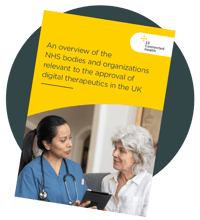At such a pivotal time for digital health, it’s imperative that healthcare organizations take the necessary steps to ensure the quality and adaptability of the technology they use. That’s why it was promising to see the NHSX recently outline new Digital Technology Assessment Criteria (DTAC) for the development of digital health technologies intended for use within the UK healthcare system.
The document outlines clinical safety, data protection, technical security, interoperability, and usability and accessibility requirements, designed to guide companies looking to develop digital health solutions.
While a valuable checklist of criteria for NHS-friendly health tech, the DTAC is just a baseline; a starting point upon which to build more specific guidelines in order to ensure digital health solutions are adopted and make an impact in the long-term.
Here’s what the new criteria means for the improvement of digital health in the UK, and what more needs to be done to build on this foundation in future.
Encouraging high-quality health tech
With digital health provision rapidly accelerating since the beginning of the pandemic, the number of potential technologies for use has grown considerably. The DTAC intends to streamline the path between the development and procurement of health tech in the NHS, and ensure the technologies approved are of a higher standard.
However, it’s one thing to have an approved solution for the NHS, and quite another for that solution to actually be used in the NHS.
The baseline criteria outlined by the NHSX certainly goes some way towards encouraging higher quality health tech, however, developing technologies that stand the best chance of adoption into the healthcare system requires extra consideration and direction.
After all, the success of a digital health solution is built on a myriad of aspects, quality being just one. Greater appreciation of how solutions must fit within the patient journey and existing clinical processes is needed to improve adoption; something the DTAC touches upon, but further iterations should clarify.
Driving efficiency for clinicians
Another key barrier to the adoption of digital health solutions by clinicians is how any given tool will integrate into (and improve) the way care is currently provided. For example, if clinicians perceive it to add complexity or time to their day, even the best laid solutions will fall at this hurdle.
While the DTAC provides baseline technology and security standards, and encourages consideration of how the solution will integrate within patient and clinical services, companies need to understand the complexity of this task at a much deeper level.
More than a checklist of criteria, in-depth stakeholder and key opinion leader (KOL) research, interviews, and testing is required to ensure solutions are designed and built taking usability into account at all levels.
By doing so, digital tools should end up driving efficiencies for clinicians – and other healthcare users – in order to help them focus on what really matters: caring for patients and improving outcomes.
Empowering patients throughout their care
One key aim of many digital health technologies is empowering patients to self-manage their conditions, as much as possible, and play a more prominent role in their treatments. This means educating patients around living with their disease and understanding their role outside the clinic in self-managing their condition.
By outlining baseline requirements for how digital tools should be used, and by whom, the DTAC takes a step towards enabling the patient to fully participate in their own treatment. Digital health solutions that enable patients and carers to easily digest as much information on their health as possible, and allow them to communicate more organically with their clinicians will win the day for the NHS.
For example, tech that enables patients to track their status, administer their own medicines, and log symptoms or adverse impacts, can give doctors an accurate, up-to-date picture of their well being, and trigger more informed decisions on when and how to intervene.
Not only this, but making patients feel in charge of their journey actually drives better outcomes. After all, while clinicians know more about the disease, patients will be the first to perceive how they’re responding to a treatment, so tools like digital home monitoring, used in conjunction with disease education, make patients feel motivated to continue, or help inform how to adapt if the treatment isn't working out.
What’s next?
To its credit, the DTAC is a good first step along the road to better digital health, and other healthcare organizations would do well to follow suit by issuing similar guidance. However, there is plenty more work to be done to ensure digital solutions are not only approved, but adopted successfully into healthcare systems.
So, while the NHSX criteria will ensure basic foundational commonality between the digital health tools that gain approval, the DTAC lacks any real guidance on adoption beyond that point.
Service design, for example, is a key part of any adoption plan, and little attention is given to this under the DTAC. Developers must think about how their solution will fit within a clinical setting, what resources will be required to implement it, and whether healthcare providers will have the time and opportunity to train others – like patients – to use it. The greater the barriers to use, the less likely a technology is to have a place in an NHS context.
That’s why collaborative partnerships between digital health providers, like us, and the medtech or pharmaceutical companies seeking to bring solutions to market are so important. By working together, we develop digital health technologies that not only meet the clinical needs of users, but satisfy the value propositions of broader stakeholders, as well. Going beyond what is laid out in the DTAC means setting the bar higher to ultimately improve NHS services and patient health in future.
Kevin Hanley MD,
Clinical Engagement Director,
S3 Connected Health
For more info on digital health in the NHS, download our whitepaper: 'An overview of the NHS bodies and organizations relevant to the approval of digital therapeutics in the UK'

%20from%20NHSX.jpg)

